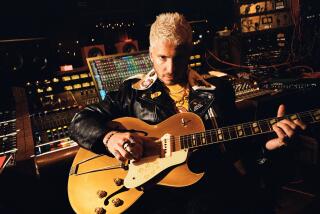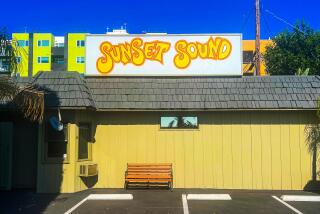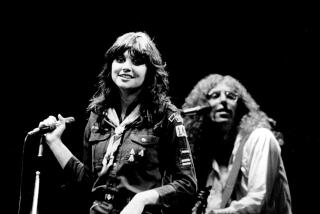The Sound of Software
- Share via
Moonshine Music’s recording studio in West Hollywood takes up only a room and a half, yet it’s stocked with hundreds of pieces of classic recording gear.
There are famous-name guitar and bass amplifiers and speaker cabinets, all warmed up and ready to shake the walls. Microphones from dozens of manufacturers await to add their particular color to a singer’s voice. There’s even an array of compressors, limiters, delays and other signal-processing gear to shape the sounds coming in and out of the 64-track recorder.
The thing is, none of them is real. They’re just pieces of software on the studio’s Apple computer.
Software and computers have transformed the way music is recorded, changing not only the process but also the sound of everything from Grammy-nominated hits to homemade demo tapes. They have slashed the cost of studios, put broadcast-quality sound within the amateur’s reach and opened new creative avenues.
The shift has also spawned a slew of companies that focus on sound-editing tools, many of which try to reclaim the sound of fabled pieces of equipment or instruments. Others correct the foibles of human performers or fit disparate sound samples into a seamless mix.
There are plenty of drawbacks too as even devotees of the new tools freely admit.
“You spend a lot of time going, ‘Wow, I can do this, I can do that,’” said Jerry Harrison, a producer, solo artist and member of the influential band Talking Heads. “You can do too much, and you can spoil music.”
Added Richard Elen of Apogee Sound International, a recording-equipment company, “What’s very tempting to forget is that a good song, good playing and performing are actually important. There is an assumption, which has been there for years and years and years, that you can make up for the talent in the mix, or in the recording as a whole. That’s [baloney], really.”
Many producers and engineers also argue that recordings done on a computer simply don’t sound as good as those done the old-fashioned way, on magnetic tape. But there’s one thing everyone agrees on: It’s a heck of a lot easier to edit a song with a computer than with a razor blade.
There are two main steps in recording music. First, instruments and vocals are recorded onto separate tracks, typically filling 24 or more of them. Then the tracks are combined into a final stereo or surround-sound mix, with a variety of effects added to enhance the sound.
The traditional approach was to use a multitrack tape recorder connected to a banquet table-sized mixing console, which provided separate volume and effects controls for each track. A studio also had multiple racks of signal-processing equipment to groom the sounds on each track, and another professional-grade tape recorder to capture the final mix.
In the past decade, computers have gradually taken on all of those tasks. Hard drives substitute for magnetic tape, plug-in cards and computer mice take the place of mixing consoles, and software emulates compressors, limiters and reverbs.
The result has been revolutionary. The painstaking, irreversible process of editing and mixing a song on tape is being replaced by a highly automated technique that encourages freewheeling experimentation.
“It’s sort of the same as the difference between a typewriter and a word processor,” Harrison said. “The computer-based systems allow you to do the kind of editing that you do with a word processor, but with sound.”
The studio at Moonshine Music, an independent label that specializes in dance music, has a few tall racks of synthesizers, samplers, drum machines and signal-processing gear. But the centerpiece is a high-powered Apple computer with a huge hard drive and two monitors, running a popular digital recording and editing program called Pro Tools from Digidesign Inc. of Daly City, Calif.
One monitor shows a measure-by-measure breakdown of the song being recorded on the Mac’s hard drive, with various voices and instruments assigned to different tracks. The other displays a virtual mixing board, with sliders and knobs to control each track.
The in-house producer is Dave Aude, a DJ and recording artist who has produced CDs or remixes for DJ Keoki, Madonna, BT and others. Using a trackball mouse, Aude can quickly copy, cut or move sounds anywhere in the song, as well as insert new elements pulled from a storehouse of digital recordings. He also can apply a seemingly endless array of sonic effects, all based in software.
For example, if he wants a guitar he’s recorded to sound as if it were played through a particular Fender amplifier, he’ll pull down a menu of amplifiers and call up an electronic simulation. The amp’s control panel will appear on screen, and Aude will twiddle the volume and tone knobs with his mouse until he’s achieved the desired effect.
The computer provides so much power to manipulate sound, it blurs the line between editing and creating.
Several years ago, Aude and engineer Steve Miller went into the studio with a couple of drummers to record a variety of percussion sounds and rhythms. They’re still inserting the results in their work, although the original drummers probably wouldn’t recognize it.
“I can take a one-bar drum loop, split it into eighth notes, rearrange it, and it’s a completely different sound,” Aude said. “I can record a guy playing for five minutes, and use pieces of that on 50 songs.”
To be fair, Miller said, he and Aude either obtain musicians’ permission to reuse the material or compensate them on a song-by-song basis.
Another example comes from the production duo of Brian West and Gerald Eaton, a.k.a. Track and Field, who are up for a Grammy for their work on Nelly Furtado’s debut CD, “Whoa, Nelly!” The two did much of the recording on computers in West’s attic and a small studio they built in Toronto, avoiding the expense and time-is-money issues of a big studio.
“It kind of takes the pressure off,” West said. “It makes the performer more relaxed. It allows you to explore more ideas, instead of just finding the thing that works.”
Furtado recorded multiple different, improvised melodies for each of the songs. Then West and Eaton digitally spliced them together, sometimes grafting in only a word or a syllable from a track.
“That whole sort of live-or-die element of editing on tape is gone,” Eaton said. “There’s really nothing you can’t edit together in terms of audio right now. It’s just really, really handy. It keeps all the options open.”
Although the duo has embraced computers for editing and mixing, West still prefers the sound of old analog equipment. That’s why the two still use older gear to capture sounds onto a computer and record final mixes onto tape “to fatten up the sound [and] round out the bottom, which tape has an unusual ability to do,” West said.
The allure of analog sound quality has been a blessing for Universal Audio Inc. of Santa Cruz, which makes reproductions of vintage recording gear as well as software simulations. The company was founded by the sons of the late M.T. “Bill” Putnam, a pioneering studio engineer whose credits range from Duke Ellington and Count Basie to the Beach Boys and Ray Charles.
“I think no one doubts, except maybe a few purists, that digital [recording] has been a big boon,” said Bill Putnam Jr., chief executive of Universal Audio. “But you do get a few people saying it doesn’t have that character, it doesn’t have that warmth.... The way that [analog] gear screwed up, or misbehaved, was musical.”
It’s not necessarily easy to get those sounds, however, or even get the equipment. That’s why there’s a demand for software-based re-creations from the likes of Universal and Line 6 of Agoura Hills, which digitally models the sound of classic amplifiers and signal-processing devices.
“If you just went and got an Echoplex”--a processor that used magnetic tape to create echo effects--”chances are it would sound different, or potentially not work at all, being an old and temperamental mechanical device,” said Marcus Ryle, co-founder and chief product strategist for Line 6. “By doing it in software, there’s simply a knob on the screen to control how much wow and flutter, how much tape hiss....
“This is all about now doing those things on purpose, and doing it in a way that’s very controllable so that you can get the tones you want and focus on making music.”
The steadily increasing power of microchips has made this kind of modeling possible on desktop computers, enabling firms such as Line 6 to preserve the sound of older gear as studios move into the new era. “In a way,” Ryle said, “we’re almost like historians.”
At the same time, however, the shift to computers could make it more difficult to preserve recording sessions. Bay Area producer Cookie Marenco, who specializes in new age, jazz and world music, noted that every few years brings a new computer operating system, rendering many programs obsolete. If you can’t reproduce the original sessions, you can’t remaster recordings for new formats or create remixes.
Nevertheless, Marenco appreciates some of the benefits of recording on a computer. When she needs distant musicians to add or edit tracks, she can send digital copies of the recording session electronically for them to work on. She also loads snippets from her recordings onto a computer and builds them into dance tracks, “kind of like taking leftovers every day and making something new with it.”
To Harrison, there’s something liberating about the ability to fix errors in timing or intonation. The technology “allows you to play with as much expression and excitement as possible,” he said. “When it works, right it’s great, because it allows you to play without the fear of making a mistake.”
The pitfall, though, is that the technology “can make you lazy,” Harrison said. “The technicians end up having a lot to do with how the music sounds.”
*
Times staff writer Jon Healey covers the convergence of entertainment and technology.
More to Read
The biggest entertainment stories
Get our big stories about Hollywood, film, television, music, arts, culture and more right in your inbox as soon as they publish.
You may occasionally receive promotional content from the Los Angeles Times.










